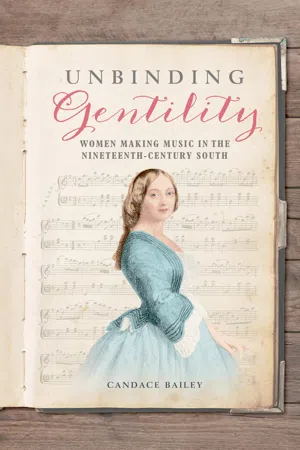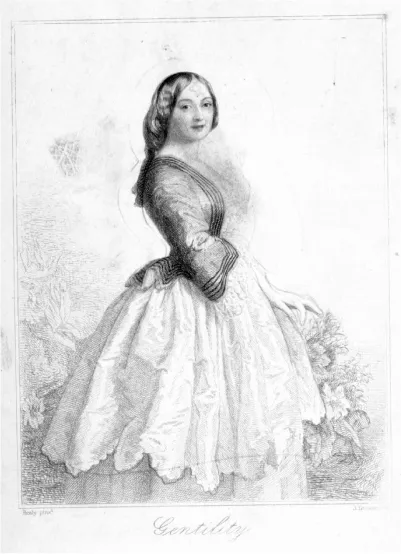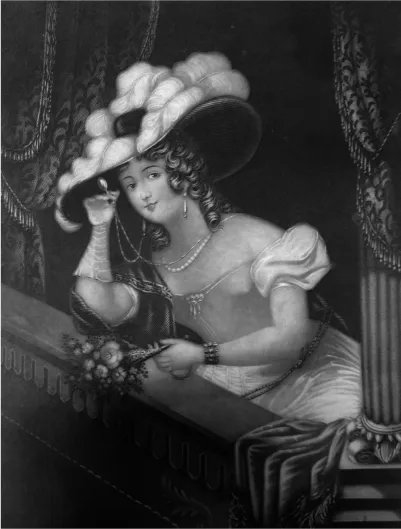![]()
PART 1
Social Diversity among Amateur Women Musicians
![]()
1
“The circle in which you move”
Gentility, Music, and White Women
During the 1850s, Sarah Ponleva “Eva” Berrien Eve (1841–90), the daughter of an affluent planter living near Augusta, played and sang music from popular operas as well as simple ballads and had her music collection bound into at least ten volumes. In the same decade, Mary Owen Stedman (b. 1840) of Fayetteville (North Carolina), also learned music from European operas and American collections, and owned a binder’s volume. Her father, an unsuccessful businessman, died during this decade, leaving his widow with eleven children. Eva and Mary, born within a year of each other, exemplify some of the diversity found in southern homes in the years leading up to the war. Their musical lives correspond in several aspects. Both attended boarding schools where music figured in the curriculum. Their binder’s volumes included music previously belonging to relatives. Both owned “Kathleen Mavourneen,” an unpretentious song reflecting Old World sentiments and stylistic features, but they also sang versions of Italian bel canto arias.
Here, however, the similarities end. Mary, along with three of her sisters, attended the Burwell School in their home state. Eva, on the other hand, traveled to Bethlehem, Pennsylvania, and Washington, DC, for her studies.1 Mary owned one binder’s volume, which she shared with her sisters and mother; Eva had at least ten for herself alone. Mary sang “Where Are Now the Hopes I Cherished,” a watered-down arrangement of “In mia man alfin tu sei” from Bellini’s Norma, and her piano versions of operatic music consist of abridged dances from Auber’s Le dieu et le bayadére. English did not suffice for Eva, and she (or an instructor) added the original-language texts to English-language versions of European arias (Italian and French). Her music from Norma was Ferdinand Beyer’s grandiloquent arrangement of the opera’s melodies; one of several from his op. 42 that she owned.
These two collections encapsulate aspects of 1850s gentility and highlight the distinctions that social status maintained as economic and cultural capital blurred the lines between classes. The differences in detail between the daughter of a successful planter and the daughter of a failed businessman justify the need for microhistories of women and their music because they emphasize the multiplicity of genteel music cultures before the Civil War. The opportunities to study music belonged neither to the elite nor the middle class alone but fell within the purview of many southerners. The practice of teaching women to read music (instructing them in “scientific music”) encompassed a wide range of social and economic backgrounds from Black women in Natchez to poor white women in rural North Carolina, from the enslaved to the wealthiest in Charleston. Moreover, their stories anticipate new directions in southern society that tend to be acknowledged only after the war but that clearly surfaced before it.
Social Class and Cultural Aspirations
Through the course of the 1830s and 1840s, southern society changed dramatically, and writers of etiquette manuals ensured the growing middling classes that they, too, could claim gentility. The next decade saw the epitome of genteel performance in the parlor, but it drove the standards ever higher as women sought to move into superior social circles that themselves had ever-rising standards for admittance. Increasing economic stratification forced a drastic restructuring of social relations.2
Planters and their relations stood at the top of the social ladder. Mary Greenhow Lee labeled the relationship between these two “visitable connexions”—a term that neatly encapsulates the variety one might have within a single circle. Friends and acquaintances might be endorsed through family connections, through social status, or (to a degree) through class, as long as they adopted the behaviors of gentility, literate music skills being one of these.3 The elite class and their visitable connexions constituted one divide, and their relationships confirm that southerners employed markers other than wealth to define their social parameters. As the bar between gentry and non-gentry dropped precipitously, gentility spread. Farmers in rural areas added parlors to their houses and furnished them with musical instruments, clerks in town read books on etiquette, and merchants of all sorts adopted prescribed manners in pursuit of gentility. Through this process, genteel culture cut across society as an independent variable social distinction that was not tied directly to ancestry or land.4 Aristocratic gentility met democratic America, and outward signs of leisure became social measuring tools for working Americans. The elite continually refined the markers of genteel status, and their musical practices reflected their need to set themselves apart. How this played out in the South can be read through Michael O’Brien’s assertion that southerners remained intellectually tethered to older European cultures, saw themselves as imperial, yet struggled against a “cultural anxiety” in determining how to create a prosperous empire, republic, and democracy on the backs of enslaved people.5 Gentility was one means of establishing order in the confused world wrought by these competing ideals.
Commodification of Gentility
The performance of gentility at home required a piano in the parlor, preferably with a bound volume of music on it. Cultural historian Lisa Tolbert uses the example of Virginia Campbell of Murfreesboro (Tennessee) to illustrate that by the 1850s, the piano had taken the place of the spinning wheel in the parlor, thereby signifying the spread of conspicuous consumption and the role of music in narrowing the gap between social classes. A visitable connexion with powerful political relatives, she married William Shelton, a professor and part-time clergyman, and moved into a six-room house. Virginia wrote that her new parlor was “handsomely … painted and papered and furnished (all except a piano, which I must procure sometime soon).”6 In other words, her parlor was not completely finished until she acquired a piano. Her acquaintances—the circle to which she wished to belong—would have judged Virginia by the public areas of her house and their presentation.7 She required a piano as part of the accoutrements of gentility.
To earn money to buy an instrument, Virginia took in boarders and occasionally taught music at the Eaton Female College beginning in 1851. The gulf between being seen at a certain level on the social hierarchy and having to earn money placed women whose economic means fell short in a difficult position. Working outside the home positioned a woman lower socially, although economic need required many to do so: imagined ideal womanhood demanded real work. Nonetheless, the tension between ideal accomplishment and real practice was surmountable, as Virginia Shelton realized. Teaching was one of the most acceptable options; in 1843 the Holly Springs Gazette (Mississippi) urged parents to consider teaching music as an honorable way for their offspring to generate a living.8 Virginia’s efforts proved insufficient, however, and her parlor remained without a piano until 1853, when her uncle gave her a piano as an attempt to overcome grief after her baby died. As a gentleman, he had been taught music’s power to soothe, and he enabled her social aspirations even while she worked to maintain her social station. Virginia and William traveled by train to Nashville to choose the piano, stool, and cover, spending $300. The piano arrived the next day, and Virginia played “several old scotch airs” for her family.9
The production of music in the parlor, rather than useful material goods such as homemade clothes, signaled a significant transformation in southern society.10 This reshaping touched all facets of the culture, enabling women who previously lacked the means to aspire to a higher rank the possibility of doing so. Music was no exception. A growing economy meant that many more women had both the means and opportunity to buy—literally—musical accomplishment. The acquisition and display of material goods, including sheet music and instruments, contributed to southerners’ cultural capital and legitimized how a young woman determined taste suitable to her station. In communities where the goods necessary for upward mobility were readily attainable, more was demanded. In less affluent areas, the continuum was smaller.
Etiquette Manuals: Guides to Gentility
Simply owning musical materials did not make one genteel: it was necessary to know how to perform gentility through music in the right manner. People claiming genteel status had to demonstrate their knowledge of the correct rules of engagement. Those with the highest social status defined the etiquette practices, and those beneath them adopted these behaviors to the extent that they could afford to do so. The production of etiquette manuals accelerated to meet the needs of a growing market that saw benefits in being able to draw boundaries between the socially acceptable and those less favored. Modern writers identify a middle-class audience for these books—a reasonable conclusion since those of the upper class would not have needed such advice because they set the rules by their own behaviors and styles.11 The manuals recommended how one displayed good taste, in essence how one performed gentility, but their rules could not address all aspects of refinement.12 No author could provide all of the necessary and explicit guidelines for appropriate style. One simply knew or didn’t what was tasteful.13
Nevertheless, this elusiveness did not impede authors from trying to explain genteel behavior and presentation, and the data gleaned from them exposes taxonomies at variance with assumptions made by modern authors. Thornwell’s aptly titled Ladies Guide to Perfect Gentility: in manners, dress and conversation, in the family, in company, at the pianoforte, the table, in the street, and in gentlemen’s society; also a useful instructor in letter writing, toilet preparations, fancy needlework, millinery, dressmaking, care of wardrobe, the hair, teeth, hands, lips, complexion, etc. exemplifies the direct instruction that marked the influence of Jacksonian democracy on American etiquette manuals.14 Initially published in 1856, Thornwell includes gentility at the piano on the title page and mentions music (and dancing) several times throughout the book.15 Her book opens with an image of “Gentility” that embodies the rules: the woman is demure but not coy, tastefully dressed without extravagance, and holds her body in a passive stance, all of which confirms her place of genteel status (see Figure 1.1). She contrasts the image that opens “The Belle of the Opera: Essays upon a Woman’s Accomplishment, Her Character and Her Mission” by Joseph Chandler in Graham’s Magazine of 1846.16 Both were intended as positive views of young women, but the differences between them are obvious.
Figure 1.1. “Gentility,” Thornwell, 1856.
Gentility personifies the characteristics that Thornwell recommends for her readers. Belle portrays an equally endorsed woman, albeit under different circumstances (see Figure 1.2). Belle performs her station in public, at the opera, within the bounds of taste. The space Gentility occupies is less specific, but her presence in a less-public space—the parlor—seems certain. Chandler clearly establishes that “the Belle at the Opera” is an ideal mother who knows how to sing in the nursery but also understands that only professionals perform in public. The parlor and musical performance in it is understood today as a ubiquitous part of the gentlewoman’s cultural experience, but how it occurred, under what circumstances, escapes most explanations, as does why women who aspired to Gentility’s personification and those who met Belle’s often performed essentially the same music in the same space.
Answers to such queries exist in part in etiquette manuals. In Thornwell’s section entitled “The Lady at the Piano-Forte,” she includes two sections of note: “Invitations to sing or play” and “Kind of songs and style of singing.” Like her contemporary authors, she insists that a lady should agree to perform when invited, if she intends to play or sing at all, without affectation or indecision. She allows that good singers “will add to the pleasure of your friends, and to their regard,” and even poor ones will evince “the desire to amuse … and will be appreciated.”17 In other words, pleasing one’s friends outweighs an immaculate performance.
Figure 1.2. “The Belle of the Opera,” Graham’s, 1846.
Music Practices among the Classes
As they had done for decades, the women of white planters’ families studied music as a prerequisite part of belonging to the elite class. Thus, musical practices associated with the parlor did not belong solely to the middle class. The expenditures of Thomas A. Person, a successful planter in Franklin County (North Carolina) on his daughter, Tempie, illustrate the investment those who could afford to do so made on music. Her Louisburg Female College tuition statement includes music lessons for $35, the use of an instrument for $10, and $6.79 for twenty-three pieces of music—this over the fees required for room, board, and general tuition.18 Considering that several of Thomas’s nine children were in school at that time, he spent a considerable amount on Tempie’s musical education. It demonstrated that he had the means to invest in what he understood a young woman needed, including a substantial amount of music. Thomas directed his children’s upbringing with specific social goals in mind, as indicated in an 1854 letter that he wrote to his two daughters (Tempie and Sallie), both at the College, urging them to “be such women as will adorn the circle in wh...


